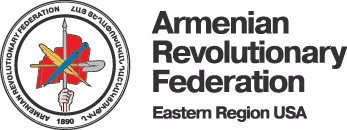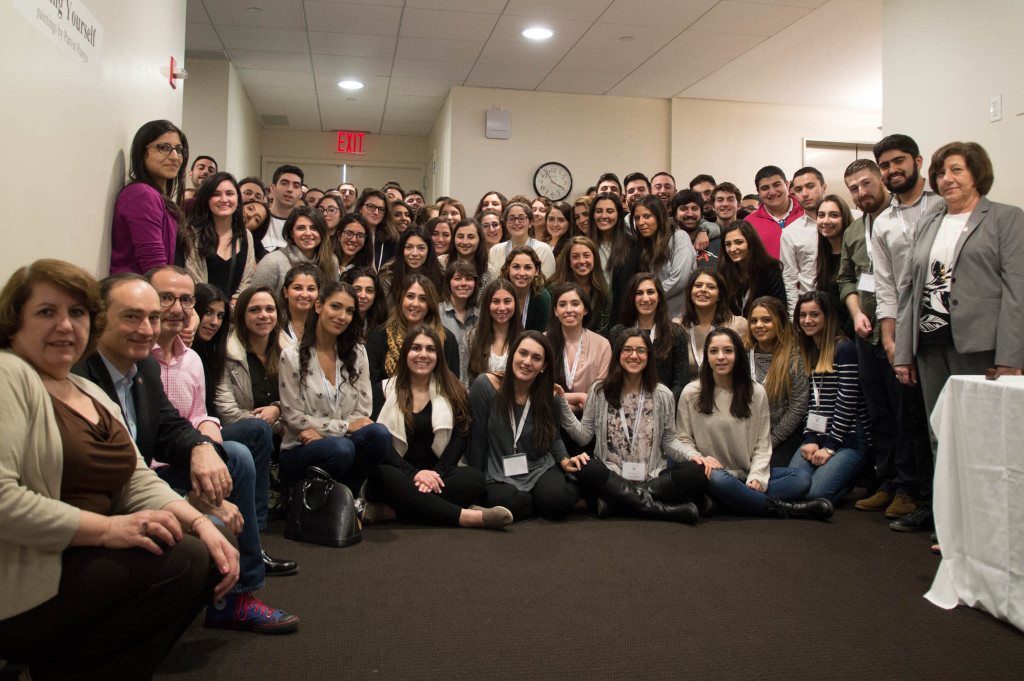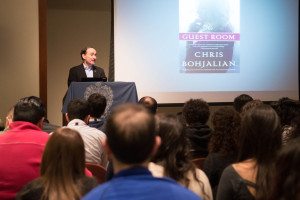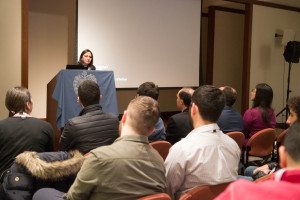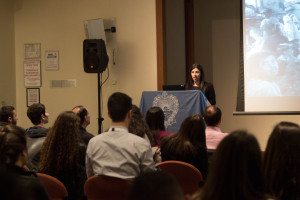YCP Program on Cultural Resistance and Responsible Activism a Resounding Success

NEW YORK—On the weekend of March 12, young Armenians from all over the country participated in the “Youth Connect Program” in New York City, in a program organized by the Armenian Relief Society (ARS) of Eastern USA. More than 100 Armenian youth, ages 18-25, as well as 6 speakers, well informed on Armenian issues, spent their Saturday at New York University’s Kimmel Center for University Life, where they explored the topic of “Cultural Resistance and Informed Activism” within, as well as beyond, the Armenian community.
The speakers at this educational and inspirational event were Chris Bohjalian, best-selling Armenian-American author; Amberin Zaman, Turkish journalist whose work often focuses on minority issues in Turkey; Serda Ozbenian, executive director of the Armenian Environmental Network; Serouj Aprahamian, former executive director of the AYF Western Region; Nanore Barsoumian, editor of the Armenian Weekly; and Dr. Khatchig Mouradian, assistant professor at the Division of Global Affairs at Rutgers University and director of the ARS Youth Connect Program.
ARS of Eastern USA Chairperson Talin Daghlian welcomed the attendees and spoke about the activities of the ARS, including the efforts to renovate the Soseh Kindergarten in Artsakh (Karabagh); maintaining Armenian schools in the region; the ARS Youth Connect Program; the camperships provided to youth attending Camp Haiastan; the collaboration with filmmaker Bared Maronian on his latest documentary, “Women of 1915”; college scholarships; and the Walk Armenia project. To learn more about the activities of ARS of Eastern USA, visit www.arseastusa.org.
Chris Bohjalian: ‘Social Justice, Human Rights, and the Novelist’
The program began with a lecture on “Social Justice, Human Rights, and the Novelist” by Chris Bohjalian, who is the author of 18 books, most of which were New York Times best-sellers. Some of his popular novels have featured Armenian characters and topics; these include Midwives, The Sandcastle Girls, and The Guest Room.
Bohjalian spoke about his “journey as a midlife accidental activist.” He discussed the intersection of history and fiction, and how he was able to “keep one foot in 1915 and one foot in 2016” in his novel The Sandcastle Girls, which deals with the Armenian Genocide.
A slideshow accompanied Bohjalian’s presentation and featured images from his trips to Western Armenia, as well as family photographs. He told the story about how he discovered that his great-grandfather was a troubadour in Gesaria (Kayseri). He spoke about grappling with feelings of doubt as he embarked on writing The Sandcastle Girls, since so many successful books had been published on the topic. The turning point presented itself during a meeting over coffee with Khatchig Mouradian, who asked him, “When will you write a novel about the Armenian Genocide?” Bohjalian emphasized that the question began with a “when,” and not with an “if.” That encounter inspired him to begin the novel about two weeks later. “I wasn’t going to write the novel for our community, because we know the story,” he said; his audience was the non-Armenian public. “As a novelist, I have a bully pulpit that I never expected to have,” he added. “I can approach a publisher and say, ‘I’m going to write a novel about the Armenian Genocide. … I never understood what I had until I turned 50.”
Bohjalian presented a slideshow of the various covers The Sandcastle Girls received in different countries, and how they drew their respective audiences. Finally, he spoke about the process of turning The Sandcastle Girls into a film, a project spearheaded by filmmaker Eric Nazarian.
Amberin Zaman: ‘Social Justice, Human Rights, and the Journalist’
Next on the itinerary was Turkish journalist Amberin Zaman, who has written extensively about Turkish politics, the Kurds, and Armenian-Turkish relations for the Washington Post, the Daily Telegraph, and the Los Angeles Times. Her speech on “Social Justice, Human Rights, and the Journalist” included Turkey’s denial of the Armenian Genocide, the difficult role of Armenians in Turkey today, and Turkish-Armenian relations.
Although there are ongoing efforts that instill hope and demonstrate change, full progress is hard to make with Turkey’s “defiant” attitude. “Turkey has to face up to the truth and apologize for the genocide,” Zaman said. The Turkish government, however, knows recognition comes with a price—returning properties to Armenians.
In order for reconciliation to occur, Armenians have to do their part, too, she said. “There is always that tension between good and evil,” Zaman continued. “Armenians have to stop thinking of all Turks as evil.”
Zaman listed a number of solutions on the path to justice and reconciliation: 1) stop destroying churches; 2) protect churches; 3) end the “ridiculous policy” of keeping the border with Armenia closed; 4) involve the diaspora in any restoration policies; 5) respect what remains of Armenian life in Turkey today. When great-grandmothers are still suffering the aftermath of the genocide, Zaman powerfully stated, “Justice matters more than mansions.”
Informed Activism in the Armenian World
Serda Ozbenian: Environmental Issues in Armenia
“Why should we care about environmental problems in Armenia?” Serda Ozbenian, the director of the Armenian Environmental Network (AEN), asked in the following presentation. An environmental researcher for 11 years, 6 of which were dedicated to environmental issues in Armenia, Ozbenian enlightened the audience about issues that are often overlooked, but equally as important to address. “Armenia is one of the world’s most unique and diverse environments,” she said, but “with a lot of biodiversity under threat.” We should care because environmental problems are linked to “public health, national security, and economic development.”
The environmental issues in Armenia include: 1) irresponsible mining, 2) irresponsible hydropower projects, 3) solid waste management, 4) wastewater management, 5) deforestation, and 6) illegal hunting. The reason why these issues continue is because of a lack of commitment to protect natural resources. Ozbenian also said, “because of corruption, the government does not follow environmental laws.”
Environments under threat included the Shikahogh Reserve, Armenia’s second largest forest reserve, and the Teghut Mine in northern Armenia. A current environmental issue involves the Amulsar Mine. Home to many endangered species and critical for brown bears, its polluted rivers and lakes could harm animals, the environment, as well as tourism, she noted.
Ozbenian’s organization, the AEN, works hard to promote sound environmental policy making, including solutions to solve the “war on waste” problem in Armenia. Unfortunately, Armenia lacks sanitary waste management, as, currently, waste is taken to dumps that do not have protective barriers.
How has the AEN addressed this issue? The group educates the public on the environment through various arenas, such as schools, the internet, and television. Ozbenian played an alarming public service announcement video, titled “You Reap What You Sow,” based on littering in Armenia. The group also takes action to reform mining policies and wildlife/animal treatment. For example, in the Gyumri Zoo case, the owner said he could no longer take care of the animals in the zoo. Because of the AEN’s efforts, the animals will be moved later this month.
What can the public do to help the environment in Armenia? Ozbenian suggested, “Volunteer, stay informed, write a blog for AEN’s website, research, and donate to effective organizations, offer technical assistance and advice to NGO’s, and start an AEN chapter.” To learn more about the Armenian Environmental Network, visit www.armenia-environment.org.
Serouj Aprahamian: ‘Social Movements in Armenia’
Serouj Aprahamian, the former executive director of the Armenian Youth Federation (AYF) Western Region, moved to Armenia to work on human rights issues with the Foundation Against Violation of Law (FAVL) and Oxfam. His speech addressed “Social Movements in Armenia” that have both been effective and ineffective. Interestingly, when he presented the slide “What hasn’t worked?” many politicians’ faces popped up on the screen, including Vazgen Manougian, the former prime minister of Armenia, Levon Ter Petrosyan, the first president of Armenia, and Serge Sarkissian, the third and current president of Armenia. The common thread running through all of these politicians’ tenure is a rigged election and a promise of change without it materializing. “It’s the same story,” Aprahamian said. “It’s like a repetition of the same TV show.”
Since the 4,000 NGO’s in Armenia do not get government funding, and therefore, lack much power in changing policy decisions, the Armenian public has stepped up in its efforts to create change.
A few movements of effective social activism led to the conservation of a waterfall, the reversal of a law that would have increased public transportation costs, the privatization of social security, and the famous “Electric Yerevan” movement that forced the government to retract the rise in electricity prices. What are the common threads running through these policy changes? People occupied territories and protested against unjust laws until change was made. These movements were also democratic, youth-led, and did not have a leader. These nonviolent protests, however, came with resistance. “Police are uncomfortable with nonviolent acts,” Aprahamian said. During the Electric Yerevan protests, police “didn’t know how to react.”
One may wonder what exactly spurred this sudden wave of activism that made protesters continue standing (or sitting) firmly in place in the face of opposition. “Each movement produced new activism,” Aprahamian explained. People adopted “a different approach to consciousness and thinking.” Social activists, many of them Armenian youth, not only reversed policy decisions, but also the familiar saying in Armenia of “Yergeeruh Yergeer Cheh” (This country is not a country). They were no longer hopeless and helpless.
Aprahamian urged Armenian youth in the diaspora to be socially active, too, by providing moral support and knowledge, visiting Armenia, participating in projects and programs there, and donating to worthy causes. “You got to do this from the bottom up,” he said. “At the end of the day, it’s about coming together with like-minded people.”
Nanore Barsoumian: Activism in Communities within and beyond Armenia
The program took an unexpected turn when the next speaker, Nanore Barsoumian, editor of the Armenian Weekly, began her presentation with a picture of Tamir Rice, a young African American boy killed by Cleveland police. “Who knows the name of this boy?” Barsoumian asked the audience. She quoted Istanbul-Armenian activist Sayat Tekir from the Nor Zartonk movement, who, during a recent presentation in Boston, had said, “The equivalent of Turkey’s Armenians are not Armenian Americans or French Armenians; they are Black people in the United States.” Hrant Dink and Sevag Balikci were two men targeted and killed for being Armenian. Balikci was killed on April 24, 2011, on Armenian Genocide Remembrance Day. This violent manifestation of racism and prejudice against minorities has been a common issue in the African-American community since slavery; Rice was one such victim.
Barsoumian made more connections between seemingly different groups, individuals, and movements to show similarities in struggles and peoples’ aspirations, as well as the need to unite against injustice on a wider scale. She linked Armenian refugees during the Armenian Genocide to Jewish refugees during the Holocaust and Syrian refugees today who are “turned away because of discrimination.” She also noted the more positive effects by activists and movements from other groups—i.e., Zabel Yesayan, an Armenian feminist in 1911, drawing inspiration from a Norwegian feminist; and “Occupy Teghut,” a movement to save a forest in Armenia, drawing inspiration from the “Occupy Wall Street” movement in New York City—and asked whether a cross-pollination between movements was possible.
When addressing the audience, Barsoumian said, “You college students are the best group to make changes and build bridges.” College students already started making changes with the “Divest Turkey” movement—similar to the Boycott, Divestment, and Sanctions (BDS) movement—calling for universities to divest all holdings in Turkey’s government until reparations for the Armenian Genocide are met. However, activism does not start and end in the group to which we belong. Barsoumian urged Armenian youth to stand up for issues outside the Armenian community. “It’s as important to be active here, as it is there [Armenia],” she said.
Audience Participation
Throughout the day, the group of intellectually curious and culturally active youth participated in a question-and-answer session. One audience member stated that we should steer away from the idea that we are trying to save Armenia. “We should come from an equal level playing field…and come together strategically.” Khatchig Mouradian agreed, stating, “We, in turn, need Armenia to sustain ourselves both as a community and as individuals.”
Coinciding with the message of Barsoumian’s speech, Mouradian invited participants to share their experiences from working with non-Armenian rights groups and movements. Audience members responded with examples of Native Americans who “can understand that sort of suffering…that sort of injustice,” as well as the genocide in Darfur and the Israel-Palestine conflict. Barsoumian stressed the importance of focusing on the issues, instead of the people, especially if our goal is to explore solutions for common injustices.
Khatchig Mouradian: Cultural Resistance: The Role of the Armenian Youth
The final speaker, Dr. Khatchig Mouradian, told stories from the culmination of his 20 trips to Western Armenia, and urged Armenian youth and women, in particular, to take an active role in Armenian issues. Mouradian, the former editor of the Armenian Weekly, holds a Ph.D. in history from the Strassler Center for Holocaust and Genocide Studies at Clark University and currently teaches courses on imperialism, mass violence, and concentration camps at Rutgers University. He presented a photograph of his latest trip to Western Armenia, which portrayed Birthright volunteers, this author included, surrounding the monastery on Gdouts Island in Van as a sign of solidarity.
“We are so different in so many ways,” Mouradian explained. “The only common thread among all Armenians is choice.” As Armenians, we are often told we have “duties and responsibilities” to the community. However, Mouradian noted the many examples of “Islamized Armenians” in Western Armenia who have made a choice to be Armenian. Thinking of engagement and activism as a matter of choice “exercises your agency,” he told youth. “You are not doing it for dead people or people who are alive—you are doing it for yourself.”
Standing amongst the destroyed, half-ruined monasteries and churches in Western Armenia is saddening, but these scarred structures are proof that Armenians have an “unexplainable sense of defiance…telling you we are still standing,” Mouradian stated. Some Islamized Armenians have made the choice to reconnect with their roots. When a group of these Islamized Armenians joined the Birthright group for dinner, one of them said, “When we look at you, we see in your eyes the eyes of our grandparents who survived the genocide… We feel stronger and feel like we are not alone.”
Mouradian told the story of two midwives before the genocide who helped deliver more than 5,000 babies of different religions and ethnicities, including Jews, Muslims, Mormons, and Armenians, in the city of Aintab. The notebooks they kept of these deliveries are “a testament to community life.”
Throughout his speech, Mouradian emphasized the importance of youth and women in transforming the Armenian reality. Hearing a speech on women’s rights from an Armenian male who occupies important leadership positions was particularly inspirational, demonstrating a much-needed shift from the patriarchal attitudes in the Armenian community.
Artur Martirosyan: The ANCA-ER
Armenian National Committee of America (ANCA) Eastern Region (ER) Communications and Community Outreach Director Artur Martirosyan spoke next about the ANCA’s role and the power of the youth in advancing the Armenian cause. When describing the ANCA, Martirosyan said, “It’s about people, about local activists, who take action at a local grassroots state and federal level.” Some of the organization’s successes include the passing of a genocide bill in Michigan and Georgia’s recognition bill on Artsakh.
Along with raising awareness and demanding recognition of the Armenian Genocide, the ANCA also seeks to bring peace in the South Caucasus and speaks publicly about Azerbaijan aggression and the Nagorno-Karabagh conflict. “Azeri groups are doing their best to falsify conflicts and the Karabagh War,” Martirosyan stated. “We need people’s participation. We need mobilization of the Armenian-American community. … You are the right people to bring peace to the South Caucuses. … It comes from your souls. It comes from your commitment.”
Martirosyan proposed a number of ways for youth to get involved: Join the ANCA, do something within your university organization, and visit www.ANCA.org/action to find current appeals and encourage statesman to take action. Martirosyan advised participants to write a letter to President Barack Obama urging him to help stop Azerbaijani’s aggression and ensure peacekeeping measures, as well as increase U.S. aid to Artsakh.
Source: Armenian Weekly Mid-Atlantic
